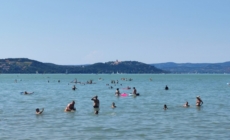-
Last Night in Baseball: Blue Jays Dominate Tigers, Stand Alone Atop AL - 10 mins ago
-
Commentary: Trump’s order on homelessness gets it all wrong, and here’s why - 20 mins ago
-
Taylor Swift’s man Travis Kelce shares rare photos from offseason ‘adventures’ - 23 mins ago
-
Lake Balaton Cross-Swim Postponed Due to Storm Risk - 32 mins ago
-
Max Homa Reveals Wife-Related Reason to Desperately Need a Win - 36 mins ago
-
Home Wi-Fi security myths: Hidden dangers and how to protect yourself - 37 mins ago
-
Trump says Hamas ‘didn’t really want to make a deal’ - 41 mins ago
-
2025 MLB Trade Grades: Mariners Get A Boost, D-Backs Begin Likely Rebuild - 53 mins ago
-
Fear of ICE raids is making heat intolerable for immigrant families - about 1 hour ago
-
Government Secures Expansion Pledges From French Business Giants - about 1 hour ago
Lake Mead Faces Worrying Water Levels for 2026, 2027
Lake Mead, along the Nevada-Arizona border, the largest reservoir in the U.S. by capacity, could hit worryingly low levels in the coming years, according to officials.
Why It Matters
Lake Mead, capable of storing about 29 million acre-feet of water, supplies drinking water to tens of millions of people. The reservoir, along with upstream Lake Powell, hit historic lows in 2022.
What To Know
According to projections from the United States Bureau of Reclamation (USBR), water levels at Lake Mead were expected to fall to 1049.15 feet by the end of December 2026.
After a slight rise in the following months, levels would then drop to 1038.39 by the end of June 2027, according to the agency’s “most probable” forecast for Lake Mead’s end-of-month physical elevations, based on 24-month study inflow scenarios.
Daniel Slim/AFP via Getty Images
Historic end-of month elevation USBR data for the reservoir shows that the last time Lake Mead saw similar levels was in 1937, not long after Hoover Dam’s completion, when an elevation of 1,031 feet was recorded in March.
“These projections are for sure serious and indicate that, without a good runoff year this coming winter, larger annual cutbacks in deliveries will be in the not-too-distant future. As the saying goes, you pray for the best but plan for the worst,” Sharon Megdal, director of the University of Arizona Water Resources Research Center, told Newsweek.
Recent projections from USBR also suggested that Lake Powell, on the Colorado River between Utah and Arizona, could potentially see water levels drop low enough to halt hydropower generation by December 2026, according to “probable minimum” forecasts.
As of Tuesday, Lake Mead’s water level was at 1,054.69 feet, USBR data showed. The reservoir was 31 percent full.
What People Are Saying
Sharon Megdal, director of the University of Arizona Water Resources Research Center, told Newsweek: “In many ways, we are in a situation similar to 2022, but the following year we got a reprieve due to excellent snowpack and runoff. We cannot count on a reprieve, which means that water users throughout the Colorado River Basin must anticipate deeper cuts.
“Residents in communities relying on Colorado River water should ask their water managers what these conditions mean for their water utilities, because impacts are not necessarily evenly distributed across users.”
A USBR spokesperson previously told Newsweek: “Reclamation continues to closely monitor hydrologic conditions in the Colorado River. We are proactively working with our partners to ensure readiness if drought response actions are needed.
“Projections beyond the 2026 operating years for Lake Powell [water year] and Lake Mead [calendar year] assume a continuation of current guidelines, which are expected to change through ongoing development of post-2026 guidelines.
“We are actively engaging with our Colorado River Basin partners as we work towards long-term operational agreements for the river after 2026.”
What Happens Next
A study this year found that if states within the Colorado Basin increased their water reuse rates to 40 percent, they could collectively conserve close to 900,000 acre-feet of water each year—sufficient to meet the needs of almost 2 million households.
Source link






























